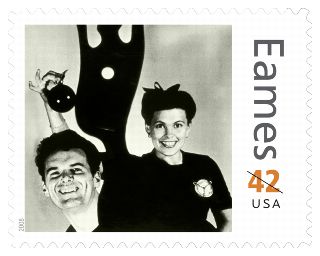
In June, the Postal Service will dedicate a pane of 16 stamps to honor designers Charles and Ray Eames. Perhaps best known for their furniture, they were husband and wife as well as design partners. Their extraordinary body of creative work — reflecting the nation’s youthful and inventive outlook after World War II — also included architecture, films and exhibits. The Eameses used new materials and technology to create high-quality products that addressed everyday problems and made modern design including molded plywood chairs available to the American public.
Charles Ormond Eames, Jr., was born in St. Louis, Missouri, June 17, 1907. He studied architecture briefly at Washington University in St. Louis. He worked as an architect before joining the Cranbrook Academy of Art in Bloomfield Hills, Michigan, in 1938, first as a student, and then as an instructor and administrator. Bernice Alexandra Kaiser was born on December 15, 1912, in Sacramento, California. She studied abstract painting in New York City, where she was nicknamed “Ray” before leaving Manhattan for the Cranbrook Academy in 1940. (She officially changed her name to Ray in 1954.)
When Charles and Ray met in 1940, they realized that they shared a strong belief in the philosophy that design could improve modern living. They quickly formed an artistic partnership that transcended both architecture and painting and was distinguished by a fascination with structure, science and technology, as well as a keen design sensibility and eye for detail. According to their grandson, Eames Demetrios, it was “a meeting of minds as well as of hearts”. They married in June 1941 and moved to Los Angeles the following month, eager to continue their design experiments in a region known for its technological innovation. Two years later, they established what would become “The Office of Charles and Ray Eames”. Located in a large warehouse in Venice, California, the Eames Office (as it is more commonly known) was the center of Eames design ingenuity for more than 40 years.
One of their most popular designs was the molded plywood chair. Introduced in 1946, the chair was mass-produced using a method for bending or molding plywood that the Eameses had developed during the 1940s. The molded plywood chair was affordable, comfortable and could be used in virtually any setting, qualities inherent in most pieces of Eames furniture. In the years that followed, Charles and Ray created other attractive and durable pieces, and they pioneered the use of plastic, aluminum and wire mesh in modern furniture. By 1978, they had put more than 40 designs into production, including sofas, tables, storage units and airport seating.
The design duo demonstrated that innovations made by wartime industries could also be adapted for residential architecture. In 1949, the Eames Office completed its design of Case Study House #8. Located in Pacific Palisades, California, the house was erected quickly using prefabricated parts available at much lower cost than traditional wood. It was part of a program developed by Arts & Architecture magazine to create single-family homes from materials and technologies developed during World War II. The award-winning design was praised around the world for its beauty and harmony with the surrounding environment, and it confirmed that modern architecture could be both attractive and affordable. The house was designated a National Historic Landmark in September 2006.
Interested in images as an effective means of communication, Charles and Ray Eames began making slide shows and short films in the 1950s. In 1959, they produced Glimpses of the USA, a multi-screen presentation that featured a collage of images of the United States during a typical day. The film, which emphasized the beauty in the similarities and differences between peoples, was shown to great acclaim at a public exhibition in Moscow. Other films, such as Tops (1969) and Powers of Ten (1977), imaginatively merged art and science for a popular audience. The couple made more than 125 films between 1950 and 1978. They also designed more than 10 richly detailed museum exhibits about science, technology, history and other cultures.
According to Charles Eames, he and Ray believed that the role of the designer is essentially that of a good host, anticipating the needs of the guest. Today most of their furniture and many of their products are still being made and can be found in private homes and public spaces across the country. More importantly, Charles and Ray Eames lived as they worked, devoting their days and nights to sharing their sense of wonder and encouraging all of us to live creatively.
Charles Eames died in St. Louis, Missouri, on August 21, 1978. Ray died in Los Angeles, California, on the same day in 1988.
